Wildflowers successfully grow in outdoor spaces of all sizes! You can benefit wildlife by sowing wildflower seeds in window boxes, patio pots, borders, lawns, or in large areas.
Native wildflowers look lovely and attract helpful pollinators to your garden – great if you grow fruit and vegetables! In addition to insects, birds and mammals will appreciate the food wildflowers provide, plus the breeding and nesting opportunities offered by their foliage.
Learn how to plant wildflower seeds and start offering nature a home in your outside space!
What are the different types of wildflower seeds?
There are three main types of wildflower seeds:
Annual wildflower seeds – colourful, showy and quick to establish, annual wildflowers live fast and die young. By using all their energy to give a big burst of long-lasting blooms in their first year, plants will set seed then die. Annual flowers will not reliably reflower in following years without maintenance.
Biennial wildflower seeds – flowering and producing seed only in their second year, these plants will then die like an annual variety.
Perennial wildflower seeds – less showy than annuals and slower to establish, perennials boast the same wildlife benefits. A low-maintenance choice that’s ideal for larger plots, plants bloom year after year with a display that gets better and better. You’ll notice native varieties, including oxeye daisies and yarrow, popping up in roadside verges with no nurturing.
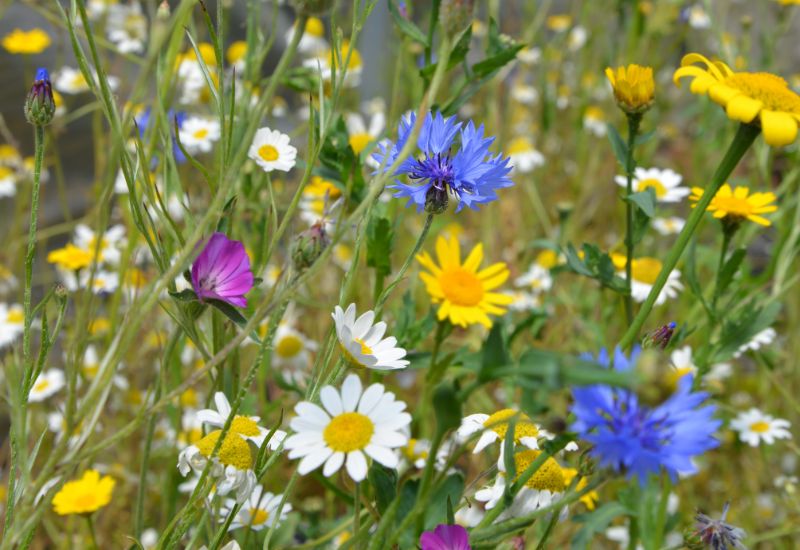
When to sow wildflower seeds
First of all, always check the recommendations on your seed packets. In general, wildflower seeds can be sown at two times of the year – from March to April or during September.
Where to sow wildflower seeds
Wildflowers appreciate relatively poor-quality soil, growing well where other plants cannot. Sow your wildflower seeds in a sunny, open area, where your plants will receive a lot of light.
Got a shady spot? Seed mixes designed for shade contain varieties that thrive in low light, such as campion and columbine, adding colour where you need it most.
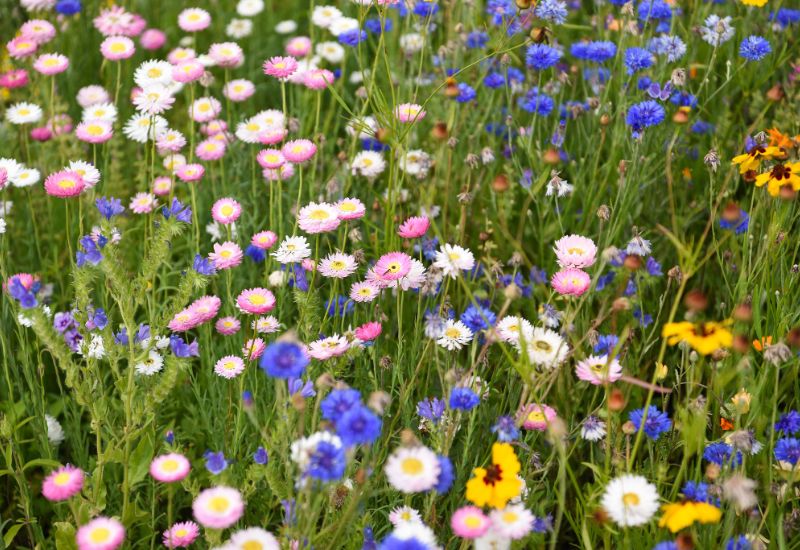
How to sow wildflowers
Simply scattering wildflower seeds on the ground doesn’t give great results, so preparation is key!
Wildflowers can be sown in containers or in gardens of all sizes! You only need a few simple steps for success – moist, weed-free soil with good drainage and lots of sunlight.
Sowing in containers
Choose a pot with drainage holes and add a layer of grit or small stones to the bottom. Almost fill the planter with a mix of garden soil and peat-free compost, leaving 3cm at the top. Sprinkle the seeds in a thin and even layer across the surface. Cover with a few millimetres of sieved soil or vermiculite. Place your planter in a sunny area and keep the soil moist.
Sowing in borders
Choose sunny area of the garden and prepare the soil by removing any weeds and raking the surface flat. Sprinkle your seeds thinly and evenly across the surface, using about 5 grams of seed per square meter. Rake the soil again and firm it down gently by treading. Water and keep the soil moist whilst your plants establish.
Sowing in lawns and larger areas
Wildflowers won’t thrive in existing lawns. The highly-fertile soil encourages vigorous growth in grasses, which smother all but the most tenacious weeds. Start by clearing the turf, remove any deep-rooted weeds and rake the soil surface level.
For the best results, we recommend sowing approximately 5 grams of seed per square meter. To sow, walk across the area scattering seeds as you go, aiming for even distribution, before raking over the soil. Walking back over the sown area will help the seeds bed-in. As with any sowings, you’ll need to keep the soil moist until the plants are established.
Unable to clear the grass? Yellow Rattle is a great native wildflower for suppressing the growth of grasses. Clear a few patches of soil and sow this amazing annual for a natural way to convert grassland to meadow!
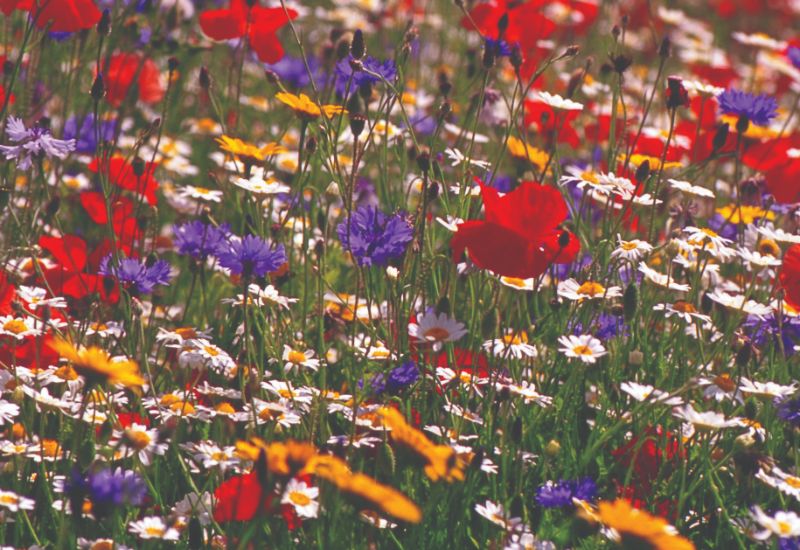
How to care for wildflowers
Wildflowers thrive in poor soil, so using compost or fertiliser merely encourages grasses to grow. Like most plants, wildflowers need moisture to grow, so keep the soil watered – especially in hot weather. Remember to check for grasses and weeds regularly and remove them before they set seed and spread.
How to maintain your wildflowers
After flowering, wildflowers will set seed in autumn and it’s important to wait for this to happen. After they have set seed, the area should be mowed and all cuttings removed. This reduces soil fertility, providing the right conditions for your wildflowers to re-germinate and thrive. Leave the cut stems on the ground for up to 7 days, to allow the dried seeds to fall out. Trampling or rolling the area will help distribute the seeds more widely and help them bed down into the soil. You can cultivate and/or reseed in September or March – both new and existing wildflower seeds thrive in disturbed soil.
Create a year-round wildflower wildlife haven
Why not leave the faded flowers and foliage uncut for as long as possible, ideally until late winter? The dead plants offer a wildlife haven during the coldest months. They provide a habitat for small mammals and insects, including the chrysalises of the coming summer’s butterflies. Simply mow the area in early spring to give the new shoots the light and air they need to succeed.
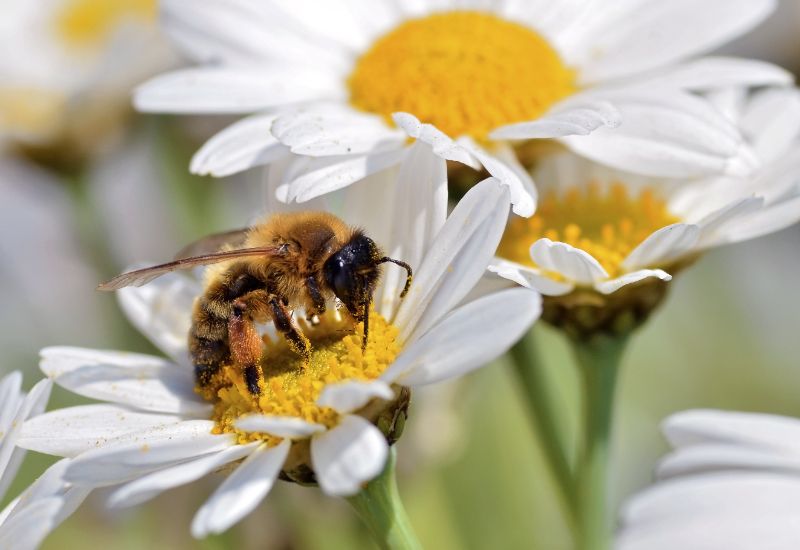
Now you know how to plant wildflower seeds!
Whether you’ve got a large garden or a patio pot, we have a wildflower seed mix for you! Get the best expert advice on sowing and growing wildflower seeds in our blog. Check out our full range of flower seeds for even more choice.
Last Updated on October 9, 2025 by Suttons Horticultural Team

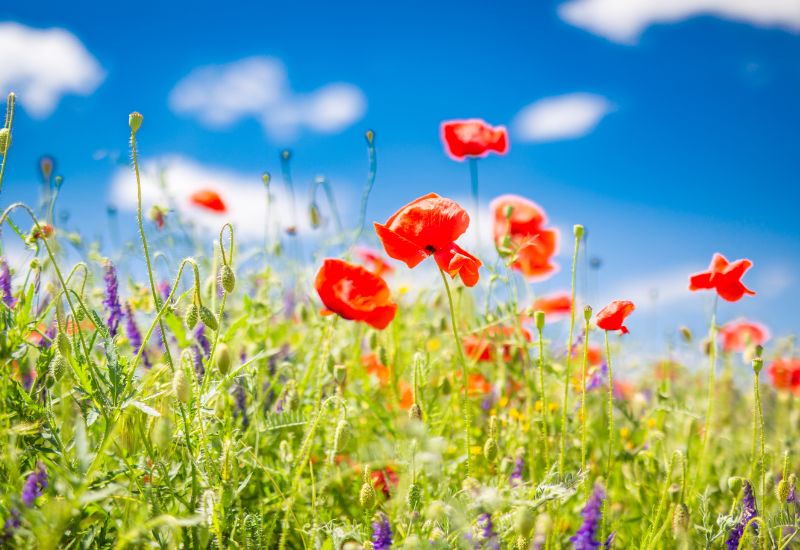




I have a lots of wile flower seeds, what is the best months to put them in the soil?